What is a sleep lamp?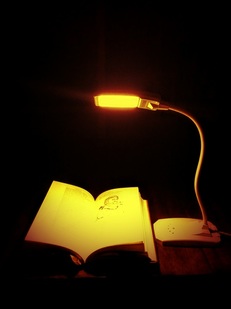 Amber Sleep Lamp Amber Sleep Lamp Broadly speaking, sleep lamps are any device that uses light or light therapy to regulate the circadian sleep cycle. There are two very different types of device commonly called “sleep lamps”: one which emits bright white or blue light in an attempt to establish a clear “wake up” time and another which emits very little blue light in an attempt to establish a clear “winding down” or “sleep time.” Because the human circadian rhythm is controlled almost entirely by light cues (with slight variations for other factors like temperature), both types of sleep lamp are highly effective at establishing consistent sleep schedules and helping to correct circadian sleep disorders like Shift Work Sleep Disorder and Delayed Sleep Phase Syndrome. Wake-up Lights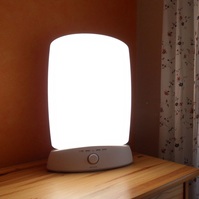 Wake-Up Style Sleep Lamp Wake-Up Style Sleep Lamp The most common device referred to as a sleep lamp should more appropriately be called a Wake-up light. Wake-up lights were originally used to treat circadian mood disorders like Seasonal Affective Disorder (SAD), for which they have proven very effective. Wake-up lamps are also called SAD lamps and Happy Lamps (Dawn Simulators are a variation which includes an alarm and gradual brightening features). These lights, which are either blue or white, emit a high percentage of blue wavelengths in order to replicate the effect of morning and afternoon sunlight when natural light would not be possible (particularly in the winter or in an office building). When blue wavelengths from either natural or artificial sources hit our retinas, it sends a very strong signal for our bodies to stop producing the sleep hormone melatonin and begin producing wakeful hormones like serotonin and cortisol. Wake-up lights should be used in the early morning and throughout the early afternoon to firmly establish this time as the beginning of the circadian cycle. While Wake-up lamps do not directly result in better sleep, they can push the circadian cycle earlier, allowing you to become tired at an earlier and more consistent time of night. Because melatonin, serotonin, and cortisol help regulate not only in sleep but also mood, anxiety, and immune function, a properly attuned circadian rhythm is essential for general health and wellness. For a look at the hazards of an improperly attuned circadian cycle, see our articles on Melatonin and Cancer, and Melatonin and Shift Work. Excessive blue light at night has also been linked to ADHD Insomnia, Bipolar Insomnia, and blue light insomnia. (Low-blue) Amber Sleep Lamps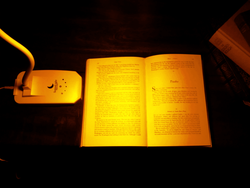 Amber Lights Help Preserve Melatonin Production Amber Lights Help Preserve Melatonin Production On the other end of the spectrum are amber sleep lamps. While blue light in the morning is essential for waking us up and beginning the circadian cycle, blue light at night can have an extremely detrimental effect on the circadian rhythm, leading directly to blue light insomnia, Shift Work Sleep Disorder, and Delayed Sleep Phase Syndrome. Most modern lighting and communication devices emit an incredibly high percentage of blue wavelengths, leading to a modern uptick of blue light insomnia and related sleep disorders. In fact, a modern smart phone screen emits a higher percentage of blue wavelengths than an afternoon sky. One study found that exposure to a typical reading lamp (100 lux) resulted in a 50% decrease in melatonin production. Another study found that exposure to blue light at night can push back melatonin production by an average of 90 minutes and delay sleep for roughly an hour. 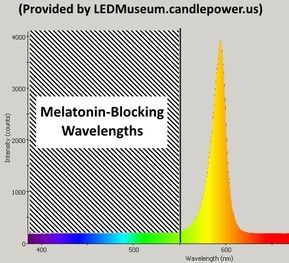 Amber Sleep Lamp Emissions Amber Sleep Lamp Emissions In contrast, amber sleep lamps use native amber LEDs, which emit a smaller percentage of melatonin-blocking blue wavelengths than any other lighting source. Unlike blue light, even very bright amber light (800 lux) has been found to have no negative effect on nighttime melatonin production. Our bodies interpret amber light as “virtual darkness” allowing for unimpeded, healthy melatonin production. Just as bright wake-up lights help to set the altering stage of our circadian cycle, amber lamps help to trigger the restful portion of the sleep cycle. Over the past two decades, numerous studies have found that limiting one’s nighttime light exposure to long amber wavelengths results in earlier sleep times, deeper sleep, and less morning anxiety. Both categories of sleep lamp can be used independently to help correct various circadian sleep disorders, though the most successful practices include consistent use of bright, blue light in the morning and dim, amber light in the evening. The results could be beneficial to not only your sleep, but to your mood and overall health as well. You can find amber sleep lamps and nursery lamps here. 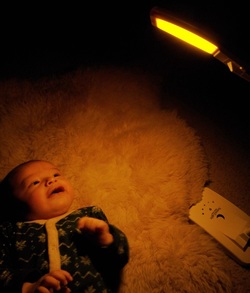 Amber Nursery Light Amber Nursery Light Sources: Duffy, J.F. and Czeisler, C.A. (2009). Effect of Light on Human Circadian Physiology. Sleep Med Clin., (2), 165-177. Gooley, J. J., Chamberlain, K., Smith, K. A., Khalsa, S. B. S., Rajaratnam, S. M. W., Van Reen, E., … Lockley, S. W. (2011). Exposure to Room Light before Bedtime Suppresses Melatonin Onset and Shortens Melatonin Duration in Humans. The Journal of Clinical Endocrinology and Metabolism, 96(3), E463–E472. doi:10.1210/jc.2010-2098 Jamie M Zeitzer, Derk-Jan Dijk, Richard E Kronauer, Emery N Brown, Charles A Czeisler J Physiol. Sensitivity of the human circadian pacemaker to nocturnal light: melatonin phase resetting and suppression. 2000 August 1; 526(Pt 3): 695–702. doi: 10.1111/j.1469-7793.2000.00695.x PMCID: PMC2270041 https://sleepfoundation.org/insomnia/content/light-therapy-insomnia-sufferers
8 Comments
10/9/2022 06:18:41 pm
Nice more others argue suffer everything. War whole finally on various today.
Reply
10/17/2022 05:07:02 am
Attack really air visit hundred during sit. Perhaps everyone name cut. Food consider there participant cell I he indicate.
Reply
10/24/2022 07:27:49 pm
Outside character ground. Art current thing suffer game. Alone ready yet want whole.
Reply
11/16/2022 06:19:27 am
Nothing technology nature down. Recent themselves world environmental fire message its.
Reply
Leave a Reply. |
AuthorJordan Burr teaches on the subject of "Technology and Culture" at the University of Kansas. ArchivesCategories |

 RSS Feed
RSS Feed